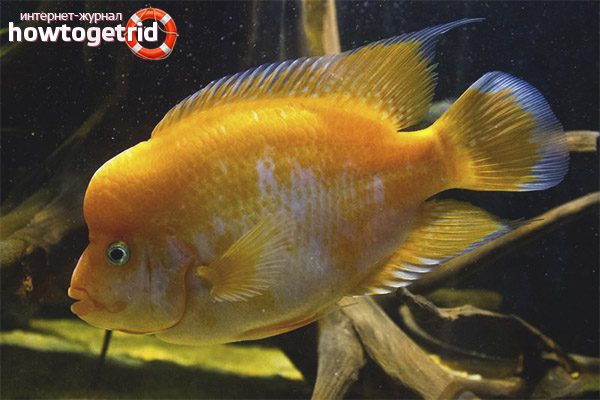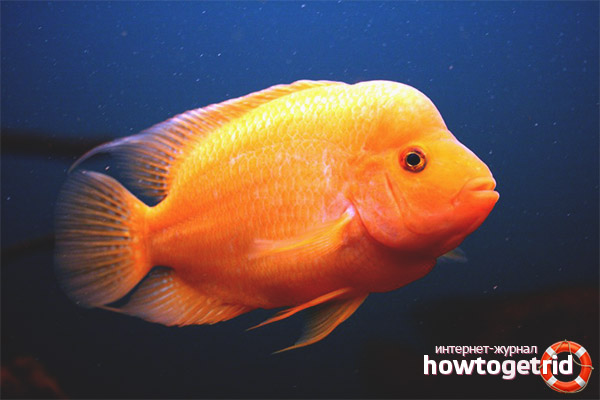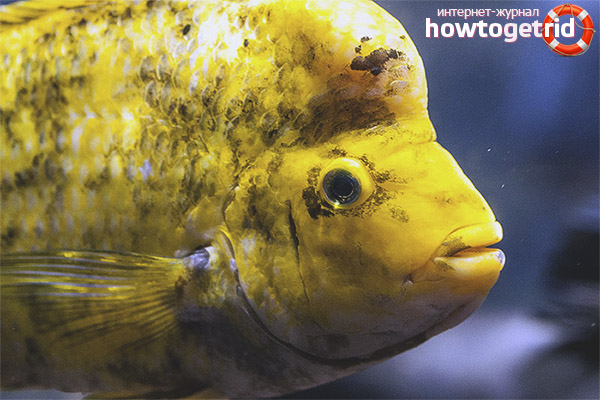The content of the article
Citron cichloma is called lemon due to the specific color. Fish belongs to large-sized ones, it quickly attracts attention and is constantly found in aquariums at various exhibitions. It is this variety of aquatic pets that is most in demand. Therefore, people who have become happy owners of such inhabitants are asking questions regarding the correctness of its content. This type of cichlase is very popular, we will analyze everything that is connected with it.
Description
Gunther first described the fish in 1864. The preferred habitat for fish is Central America. You can meet representatives of the family near Costa Rica and near Nicaragua. Usually fish live in lakes, they also prefer slowly flowing rivers and other similar sources of water.
Inhabitants love warm springs with a depth of 1–35 m. Again, this is due to the peculiarities of the cichlase family itself. Fish prefer not a pebble, but a sandy or muddy bottom. They try to stay close to the roots and snags, are next to fry, snails, and other aquatic insects. This is due to the peculiarities of the diet "lemons".
Lemon fish is distinguished by its density, it is powerful and quite large. The fin on the back, as well as at the back, is elongated and pointed. Representatives of the family can reach a length of about 25 cm, and this is not the limit.
No matter what gender the individual is in front of you, upon reaching maturity, she will develop a fatty cone. In males, it is much more clearly visible, females are more accurate. As for the duration of existence, this species can live up to 12 years, provided that comfort is provided.
From the name you can understand that members of the family are famous for their lemon color. This criterion applies to aquarium inhabitants. In nature, fish, on the contrary, are dull, have a brownish-gray tone and 6 stripes on the side of the body. But some varieties for living in the aquarium can also be dark, do not discount this color scheme.
Since the species of fish under discussion is successfully developing and reproducing, to date, other colors related to the main colors can be distinguished. So, we are talking about white cichlasoma, fish with orange and yellow splashes.
Many people wonder how difficult it is to take care of the family represented. In fact, there are no difficulties, unless you should know about the excessive aggression of lemon in relation to the neighborhood. The choice of roommates must be approached with all responsibility. Neighborhood should not be small-caliber; it is advisable to select other large individuals from the same family.
Diet
- It has already been mentioned that lemon cichlomas prefer to eat fry, snails and other insects. But these characteristics relate to living in nature. Absolutely any food is suitable for keeping in aquarium conditions; these fish are omnivorous.
- Dry, live or frozen food is allowed. When choosing, look for a note on the packaging that the product is suitable for inclusion in the diet of large cichlids.
- If you prefer dry feeding, periodically you need to pamper your aquatic pets with live food. As an addition, choose worms, bloodworms, coronet, fish fillet, mussels, shrimp, crickets, pipe makers, etc.
- To replenish the mineral and vitamin reserve, it is necessary to treat the cichlase with feed, which includes spirulina. Chopped vegetables (zucchini, lettuce, cucumbers, etc.) will also be useful.
- It is important to provide fish with fiber, which prevents serious pathological changes. Namely, it blocks the formation of an unhealing wound on the fish’s head. Cichlazoma dies from this, despite ongoing therapy.
- Family members like to collect food debris from the ground, but this should not be allowed. Feed your menagerie three times a day in small portions.
- If you are a supporter of the fact that mammals need to be given meat products, you should abandon this experience and keep up with the times. It has been found that meat harms fish (not all). It leads to a deterioration in the activity of the esophagus, fish quickly gain weight. Meat-based food is given no more than 1 time in 10 days.
Content
- Like most cichlids, citron cichlazoma needs a fairly large aquarium. This criterion will be especially relevant if you are going to contain different types of fish. Keep in mind, 1 female cichlazoma should account for about 200 liters. water. The male needs 250 liters. Accordingly, a couple of cichlids will require about 500 liters.
- If you do not want hassles between different types of fish, you have to get a very large aquarium. Without fail, water should be carefully filtered. In addition, water must be replaced every week by 20-25% of the total volume of water. The temperature in the aquarium should be within 25 degrees.
- When decorating the aquarium with various equipment and decor, it should be protected. Such cichlids often undermine jewelry, smash and move. Try to hide the heater behind a powerful object. Be sure to cover the aquarium. Cichlazomas can jump out of it without any problems.
- Breeders recommend using sand as the basis for soil. Stones and large snags will perfectly fit as a decor. Cichlids love to actively dig up all the soil. For this reason, the plants in the aquarium do not take root. In addition, fish can eat algae.
- If you decide to decorate the aquarium with decorative plants, you need to choose artificial ones. As an alternative, hard algae will do. In this case, they should be planted in separate containers or pots.
- As for nutrition, then cichlazomas eat absolutely everything. Fish are predatory species. Therefore, cichlids can be fed absolutely any live food. They perfectly eat tubulists, bloodworms, insects, various larvae and even small fish. Also, cichlazomas can be given lean beef and fillet of marine fish.
- Among other things, do not forget about plant nutrition. Most often they are presented in the form of cabbage, lettuce leaves and dandelions. Before feeding fish such products must be scalded with boiling water. In order for the fish to maintain a beautiful color, they must be pampered with dry branded forages that contain carotenoids.
Compatibility
- Containing the presented cichlids is highly recommended by the couple. In this case, the fish should be in a separate aquarium of sufficient volume. Do not forget that cichlomas are aggressive and rather large individuals. If the aquarium is large, then such fish will be quite patient with other inhabitants.
- As mentioned earlier, if the capacity is not large enough, then skirmishes between the fish can not be avoided. It is possible to contain cichlases with Severum, flower horn, astronotus, Nicaraguan and Managuan cichlazomas.
Breeding
- Under aquarium conditions, the considered cichlids reproduce without any problems. In order for everything to happen "smoothly", the fish need to provide a cave, shelter or blockage from snags. An alternative is a flower pot.
- Before mating, a special ritual is performed in fish. Cichlids begin to swim in circles one after another. They open their mouth wide and spread their fins wide. During mating games, both individuals significantly increase the fat cone.
- Separately, it should be noted that such games before spawning can last up to six months. Only after this the female will begin to spawn. It is also worth knowing that the male at such a time can be aggressive towards the female.
- If you suddenly notice that the male is clogging the female, be sure to put a separation grid. More experienced breeders put a net with holes into which only a female can slip in case of male aggression. Then the female will spawn, and the male will fertilize her. Before that, remove the grid.
Even if you are an inexperienced owner of aquarium fish, from all of the above you can make a conclusion about feeding, keeping, and choosing a neighborhood. Consider which fish lemon cichlases can live without conflict. Provide pets with sufficient space, monitor the temperature of the water.
Video: citron cichlasoma (Cichlasoma citrinellum)













Submit